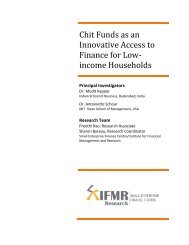Government of India Volume I: Analysis and Recommendations
Government of India Volume I: Analysis and Recommendations
Government of India Volume I: Analysis and Recommendations
You also want an ePaper? Increase the reach of your titles
YUMPU automatically turns print PDFs into web optimized ePapers that Google loves.
19.8.3. <strong>Recommendations</strong><br />
ANNEXES<br />
1. The legal framework for securities must recognise the public good nature <strong>of</strong> financial<br />
markets <strong>and</strong> establish the principles <strong>of</strong> market integrity <strong>and</strong> transparency as<br />
key regulatory objectives<br />
2. The definition <strong>of</strong> securities should be entity neutral <strong>and</strong> should be broad enough<br />
to cover new instruments that emerge from the process <strong>of</strong> financial innovation. It<br />
must include a wide range <strong>of</strong> unlisted tradable instruments for the purpose <strong>of</strong> market<br />
abuse regulations, but must have broad exemptions for the purpose <strong>of</strong> registration<br />
requirements as explained in <strong>Recommendations</strong> 6 <strong>and</strong> 8.<br />
3. The registration requirement must be entity neutral <strong>and</strong> should not therefore be<br />
restricted to companies.<br />
4. There is a need to prevent redistribution <strong>of</strong> shares by the original recipient <strong>of</strong> shares.<br />
Otherwise, indirectly an <strong>of</strong>fer may be made to a large number <strong>of</strong> persons.<br />
5. There is need for an aggregation requirement whereby <strong>of</strong>fers <strong>of</strong> the same class <strong>of</strong><br />
securities by the same issuer over a period <strong>of</strong> say twelve months are aggregated.<br />
Concomitantly, the number <strong>of</strong> 50 may need to be increased to 100 or 150.<br />
6. It is necessary to exempt <strong>of</strong>fers to qualified institutional investors who do not need<br />
as much protection as retail investors.<br />
7. There is a need to impose a registration requirement when the total number <strong>of</strong><br />
holders <strong>of</strong> the securities exceeds a threshold (say 500 or 1000) even though only<br />
a small number <strong>of</strong> investors were approached in any given year.<br />
8. It is desirable to have a “crowd funding exemption” for issues that are small in the<br />
aggregate even if they tap a large number <strong>of</strong> investors.<br />
9. The statute must explicitly state that the purpose <strong>of</strong> the registration requirements<br />
is to ensure adequate disclosure <strong>and</strong> that the registration requirement is not to be<br />
used as a form <strong>of</strong> merit based regulation <strong>of</strong> public <strong>of</strong>fers.<br />
10. Commodity derivatives should be regulated in the same way as financial derivatives<br />
while taking care to exclude genuine commercial transactions in commodities.<br />
11. The obligations to make adequate disclosures (prospectus, annual <strong>and</strong> quarterly<br />
reports <strong>and</strong> material event disclosures) must be laid down in statute <strong>and</strong> made<br />
applicable to all listed entities regardless <strong>of</strong> their legal form. The details regarding<br />
the content <strong>and</strong> format <strong>of</strong> these disclosures can be left to delegated legislation.<br />
12. There must be a statutory provision allowing the regulator(s) to impose corporate<br />
governance obligations on listed entities in relation to (a) minimum proportion <strong>of</strong><br />
independent directors in the Board <strong>of</strong> Directors (or similar governance organ) <strong>and</strong><br />
its key committees (b) financial literacy requirements <strong>of</strong> members <strong>of</strong> key committees<br />
<strong>of</strong> the board.<br />
13. The scope <strong>and</strong> objectives <strong>of</strong> takeover regulations must be laid down in statute. In<br />
particular:<br />
(a) The regulations should cover all acquisitions <strong>of</strong> 25% <strong>of</strong> the voting rights as well<br />
as creeping acquisitions by controlling shareholders.<br />
(b) Minority shareholders must be treated fairly by giving them an opportunity to<br />
sell at the higher <strong>of</strong> the highest price paid by the acquirers <strong>and</strong> the undisturbed<br />
market price by means <strong>of</strong> an open <strong>of</strong>fer.<br />
(c) While the long term goal is therefore a regime <strong>of</strong> 100% open <strong>of</strong>fers, taking into<br />
account the development <strong>of</strong> takeover financing <strong>and</strong> other relevant factors, the<br />
regulator may specify a lower size <strong>of</strong> the open <strong>of</strong>fer. The regulator(s) would be<br />
required to publish a report every five years justifying the size <strong>of</strong> the open <strong>of</strong>fer.<br />
178 FINANCIAL SECTOR LEGISLATIVE REFORMS COMMISSION



